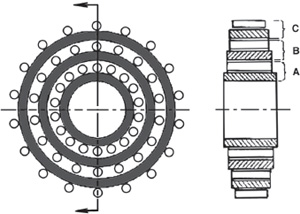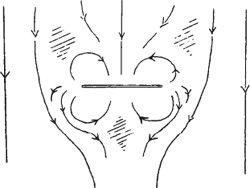Secrets of Antigravity Propulsion (40 page)

Figure 9.7.
The beam configurations for flying the Sport Model, as described by Robert Lazar: (a) the omicron configuration; (b) the delta configuration
.
To pursue an independent line of thought in regard to the delta configuration, one might imagine that these microwave soliton beams are intersected at a particular location to generate a plasma that acts as an anchoring point for wave scattering to take place.
If the polarity of the beam’s sawtooth-shaped waves are reversed to produce a sharp decline of negative electric potential at the beginning of each wave cycle or microwave burst rather than a sharp rise in potential, then it is possible that the beam could function as a tractor beam instead of a repulsion beam, as was theorized in chapter 6 in the discussion of the Podkletnov experiment.
In that case, the soliton field the craft would be creating would generate an attractive force on the craft that would be vectored toward the target region and result in propulsion of the craft in that direction.
Although so much of Lazar’s story sounds like nonsense, it is difficult to dismiss entirely when so many features of the Sport Model resemble Project Skyvault technology.
This raises a lot of questions.
If this was really one of several captured alien discs, did Project Skyvault begin as an attempt to reverse-engineer alien technology?
One can make a strong case for microwave phase conjugation having originated as an outgrowth of the World War II development of radar.
Also, there is the work of Townsend Brown, who apparently had gotten quite close to these ideas on his own without having any captured alien discs at hand to reverse-engineer.
If we are to believe that the discs were given to us by Zeta Reticulans as part of some technology-exchange program, as Lazar claims, then perhaps these beings did so because they knew that our own research had already advanced to the point that they would have little to lose to let us look at what they had.
Then there is the issue of the misinformation that was apparently given to Lazar during his employment at S-4, with the outside possibility that he also went through some sort of mind-manipulation session, as some have suggested.
If Lazar worked at S-4, was his recruitment planned from the start as a disinformation campaign to create confusion about how field propulsion vehicles might operate?
10
THE SEARL EFFECT
10.1 • THE SEARL EFFECT GENERATOR
It was during an indoor test that British inventor John Searl watched his permanent magnet generator levitate off its bench and ultimately bump into the ceiling.
As he had envisioned in his dreams, his generator was not only able to propel itself with an overunity power efficiency, but it was also able to defy gravity.
In its more advanced design, his generator consisted of three concentric ring magnets flanked by three sets of roller magnets that revolved in a clockwise direction about their circumference (see figure 10.1).
1
The innermost ring consisted of a stationary stator magnet, which he called a plate, having its magnetic north pole pointing down perpendicular to the plane of the ring.
Twelve or more roller magnets, called runners, were spaced around the plate’s periphery and allowed to roll around its circumference (see figure 10.2).
The runners were placed with their magnetic fields oriented north-pole up, so that they would be magnetically attracted to the plate’s rim as they rolled around it.
However, they were spaced so that there would always be a small air gap between their surfaces and the plate.
The diameter of the runners was such that they would revolve on their own axis a whole number of times for each revolution around the plate.
This allowed the revolving magnets to establish a condition of resonance, with each revolution reinforcing the previous to build up a stationary wave magnetic field oscillation.

Figure 10.1.
The Searl effect generator, showing the arrangement of the
concentric ring and runner magnets.
Ideally, the middle ring would have
twenty-two or more runners and the outer ring thirty-two or more runners.
(After S.
Sandberg)

Figure 10.2.
Schematic of the Searl effect generator’s inner ring and its runner
magnets, illustrating the magnetic polarity and electric polarity developed
during operation.
(After S.
Sandberg)
This inner roller ring was, in turn, surrounded by a second ring-shaped magnetic stator plate with an adjacent set of at least twenty-two runner magnets.
This was surrounded by a third ring-shaped magnetic stator and an adjacent set of at least thirty-two runner magnets.
Previous tests of smaller-sized units indicated that a negative voltage was produced at the rim of the runner magnets, allowing a current to be collected by stationary brushes contacting the runner’s rim.
In 1952, Searl and a friend conducted the first outdoor test of one of his 3-foot-diameter multi-ring generators.
2
They set the rotor in motion using a small engine that applied torque through a clutch mechanism.
Even though it was rotating at a relatively slow speed, the device produced an unexpectedly high potential at the rotor’s periphery, on the order of 100 kilovolts or more.
The large potential was indicated by the field’s characteristic crackling sound and ozone smell and the effect it had on surrounding objects.
*28
After the rotor had passed a particular threshold speed, its rate of rotation began to accelerate.
Operating on its own power, it began to lift off and break the union to its starter engine.
It is said to have risen to a height of some 50 feet, where it hovered for a while, still speeding up.
It surrounded itself in a bluish pink halo similar to the glow discharge phenomenon seen when air is ionized in a moderate vacuum.
Its pulsing field caused nearby radios to turn on.
Finally, the whole generator is said to have accelerated upward at a fantastic rate and disappeared, presumably flying into space.
Searl’s unusual device has since come to be known as the Searl effect generator (SEG) or the Searl levity disc.
In the years that followed, he and his team members built and flew some dozen or more generators, some of which similarly became lost in flight until Searl found a way of controlling the rotor speed.
He also built some generators that were 12 feet in diameter and two that were 30 feet in diameter; see figure 10.3.
There appeared to be a positive-feedback loop involved in the operation of Searl’s generators since beyond a critical speed they would begin to accelerate on their own, without any mechanical assistance from the driving motor.
In the beginning, Searl had not figured out how to control the effect.
Later, he found that it was possible to reduce the speed by electrically loading the generators so that power was siphoned off from them.
Searl found that when the generator was running, there was a dramatic drop in air temperature in the immediate vicinity of the generator and in its interior.
3
Also, there was an accompanying drop in air pressure in its interior, with air being found to move outward from the generator’s rim.
This air expulsion effect was attributed to the high-voltage ionization present along the generator’s rim, the effect being most pronounced when the rim voltage exceeded 30 kilovolts.
The high-voltage emission was believed to cause the generator to be enveloped in a vacuum.
Electrons expelled from the rim as negative ions would have arced to the positive plate, exciting a glow discharge in the low-pressure environment.

Figure 10.3.
John Searl (left) and coworkers constructing a
Searl effect generator.
(Photo courtesy of John Thomas)
The electric fields produced by the device were apparently quite strong, since Searl noticed that after he had been working near the generators when they were operating, he had a “cobweb” static electricity sensation on his skin and found that his clothes clung to him.
The fields were apparently strong enough to leave a residual electric polarity in his body tissue.
When the generator was made to hover low above the ground for an extended period, the soil was seen to become burned because of the heat from the electric currents induced in the ground.
Objects placed inside the generator ring were found to lose weight.
Also, a lit candle placed at its center became extinguished.
Whether this was due to lack of oxygen from the lowered air pressure or to lack of convection from the reduced gravity field is not certain.
Outside the generator, the field was such that objects approaching it were diverted before actually colliding.
In his 1968 paper on the Searl effect, P.
L.
Barrett presented a sketch showing the approximate direction of the gravity field in the vicinity of an operating Searl generator (figure 10.4).
4
The hatched regions indicate gravitational neutral zones, one being centered below the generator and a ringlike region positioned above the generator.
Barrett wrote that any objects that entered those regions would tend to be held there.
Also, it was found that upon taking off, a Searl craft would lift up a chunk of earth along with it.
As a result, the craft would often leave behind a large hole in the ground.
A similar lifting phenomenon has been observed to occur beneath UFOs.
Numerous reliable witnesses who observed UFOs hovering over a body of water have noted that the water peaked beneath the craft, as shown in figure 10.5.
5
The takeoff effect of a Searl-type disc might explain how a massive chunk of soil was torn up and displaced to a spot 73 feet away on a farm in north-central Washington.
6
A farmer’s two sons discovered the chunk on October 18, 1984, while rounding up cattle.
Passing through a wheat field that had been harvested about a month earlier, they discovered an irregularly shaped hole about 10 feet long and 7 feet wide, and from 1½ to 2 feet in depth.
The hole was not a meteorite crater, as it had vertical walls and a fairly flat bottom, looking as though it had been cut by a giant cookie cutter.
The removed piece, still intact, was found right-side up and rotated about 20 degrees counterclockwise from its original position in the hole.
An arc of dribblings traced a path from the hole to where the chunk was found.
By one estimate, this chunk of soil must have weighed about 5 metric tons.
The dense root mass in the soil apparently held the clump together, but some of its roots looked as if they had been torn out at the time the piece was removed, since they were seen still dangling from the vertical walls of the hole.
This feat of transportation could not have been executed by any kind of excavation machine.
Besides, there was no evidence that the removal had been man-made, nor were any machinery marks found.

Figure 10.4.
Sketch showing how the gravity field flux vectors (e.g., G-on
flux vectors) are oriented in the vicinity of a hovering Searl disc.
The vectors,
which are represented as arrows, map the Earth’s gravity field combined with
that induced by the disc.
Shaded regions indicate neutral gravity zones.
(From
Barrett, “Searl Effect,” fig.
IV)

